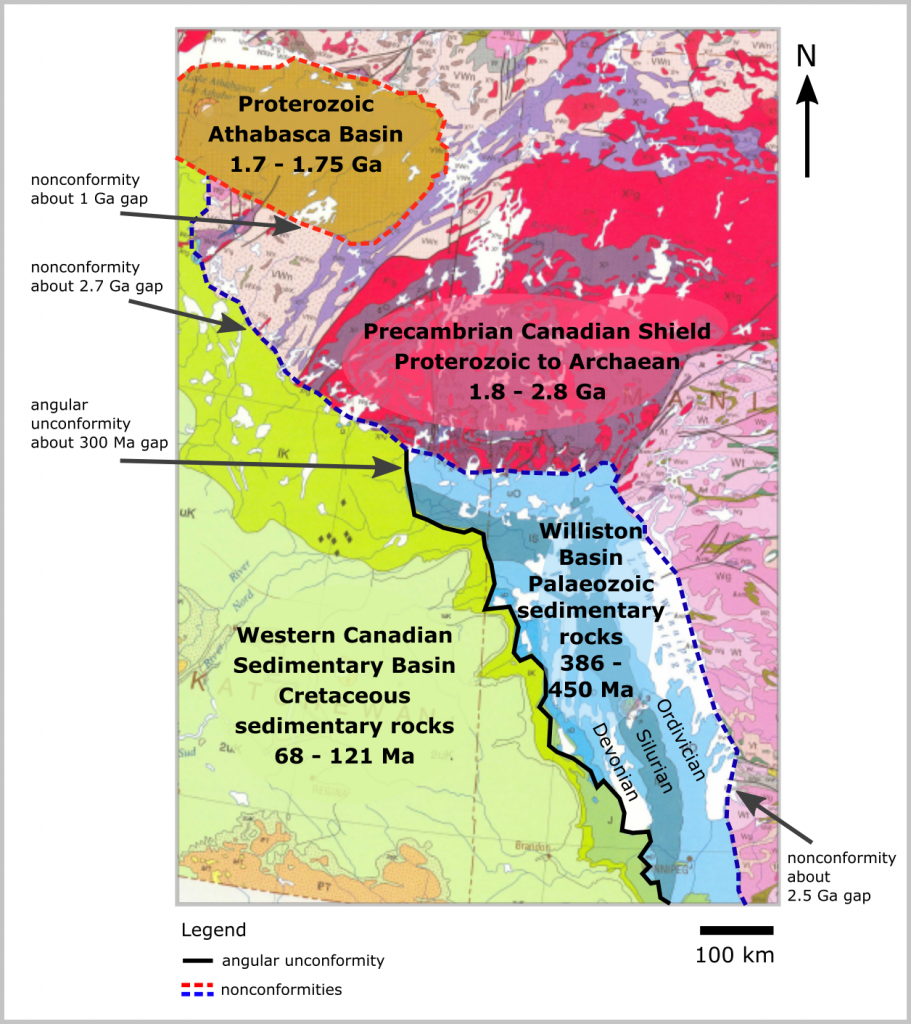Chapter 8. Geological Structures
Overview of Geological Structures Part 2: Folds, Faults, and Unconformities
Adapted by Joyce M. McBeth, Tim C. Prokopiuk, & Lyndsay R. Hauber (2018) University of Saskatchewan from Deline B, Harris R & Tefend K. (2015) “Laboratory Manual for Introductory Geology”. First Edition. Chapter 12 “Crustal Deformation” by Randa Harris and Bradley Deline, CC BY-SA 4.0. View source.
In Part II of geological structures, students will learn how stress and strain create more complex geological structures, and also how to interpret geological maps that display folded and faulted structures, as well as unconformities.
8.5 STRESS AND STRAIN
Rocks change as they undergo stress. Stress is a force applied to a given area. Since stress is a function of area, changing the area to which stress is applied will change the resulting stress. For example, imagine the stress that is created at the tip of the heel of a high heeled shoe and compare it to the bottom of an athletic shoe. In the high heeled shoe heel, the area is very small, so much stress is concentrated at that point. The stress is more spread out in an athletic shoe. If stress is not concentrated at one point in a rock, the rock is less likely to change (break or bend) because of that stress. There are three main types of stress: compression, tension, and shear. When compressional forces are at work, rocks are pushed together. Tensional forces operate when rocks pull away from each other. Simple shear force is created when rocks move horizontally past each other in opposite directions. Rocks can withstand much more compressional stress than tensional stress (e.g., Figure 8.15).

Source: Randa Harris (2015) CC BY-SA 3.0 view source
Applying stress creates a deformation in the rock, known as strain. Initially, as rocks are subjected to increased stress which begins the process of strain, they behave in an elastic manner, meaning they return to their original shape after deformation ceases (e.g., Figure 8.16). This elastic behavior continues until the rocks reach their elastic limit (e.g., point X on Figure 8.16), at which point the rock will begin to deform plastically. Plastic deformation may lead to the rocks bending into folds, or if too much strain accumulates, the rocks may behave in a brittle manner and fracture. An example of brittle behavior is a hammer hitting glass, which of course shatters the glass. With plastic deformation, the rocks do not return to their original shape when the stress is removed. The deformation that results from applied stress depends on many factors, including the type of stress, the type of rock, pressure and temperature conditions (e.g., rocks deeper in the crust will be subject to higher pressures and temperatures), and the length of time the rock is subjected to the stress. Rocks behave very differently at depth than at the surface. Rocks tend to deform in a more plastic manner at depth, and in a more brittle manner near Earth’s surface.
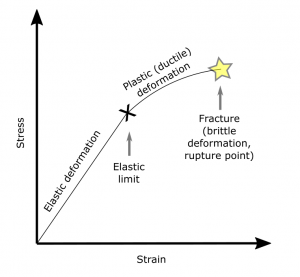
8.6 GEOLOGIC STRUCTURES CREATED BY PLASTIC & BRITTLE DEFORMATION
8.6.1 Folds
Folds are geologic structures created by plastic deformation of Earth’s crust. To demonstrate how folds are generated, take a piece of paper and hold it up with a hand on each end. Apply compressional forces (push the ends towards each other). You have just created a fold (bent rock layers). Depending upon how your paper moved, you created one of the three main fold types (Figure 8.17).

A monocline is a simple fold structure that consists of a bend in otherwise horizontal rock layers. Anticlines and synclines are more common than monoclines. An anticline fold is convex up: the layered strata dip away from the center of the fold (if you drew a line across it, the anticline would resemble a capital letter “A”). A syncline is a concave upward fold in which the layered strata dip towards the center of the fold (it resembles a “U”). Folds have three main parts: a fold axis (also known as the hinge line, which is the line that runs along the nose of the fold), the axial plane (an imaginary plane that contains the hinge line and generally bisects the fold), and limbs on either side of the fold axis (Figure 8.18). Note that anticlines are not always hills and synclines are not always valleys; in other words, folds are not always reflected in the current topography in a region. This is generally due to erosion wearing away the layers of rock to expose the rocks inside of the fold (Figure 8.19).
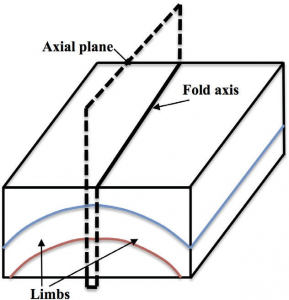
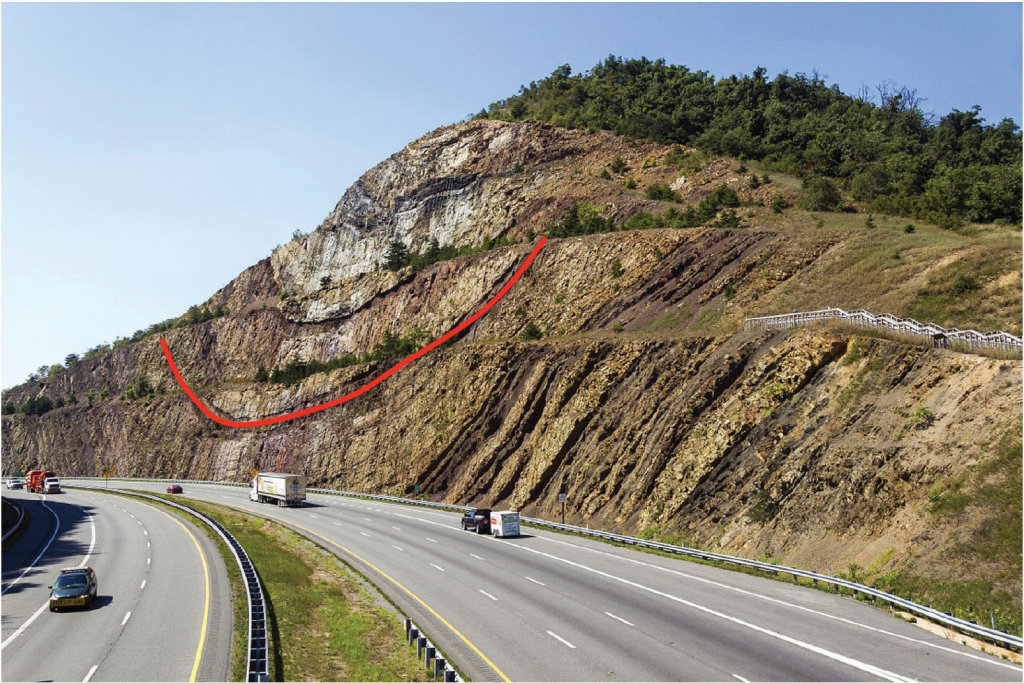
Folds observed in cross-section look much different from map view. In the map view of a flat surface, upright folds will appear as linear beds that look like Figure 8.20. To help determine what type of fold is present (monocline, syncline or an anticline), you must determine the strike and dip of each of the beds. On Figure 8.20, you can practice this: determine the strike and dip for each location marked by an oval. Check your answers using Figure 8.21.
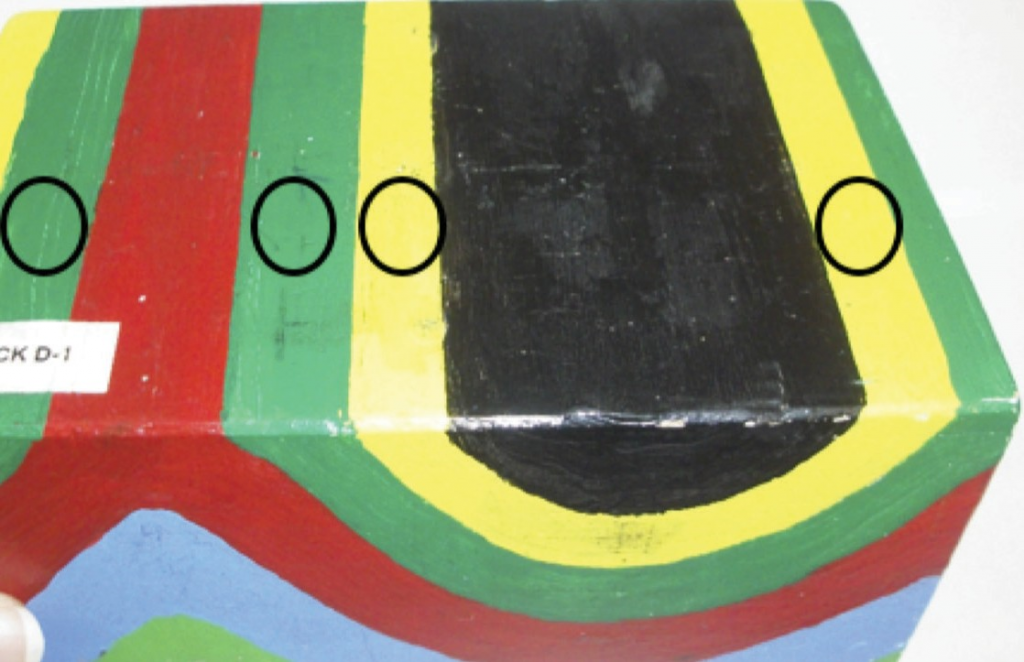
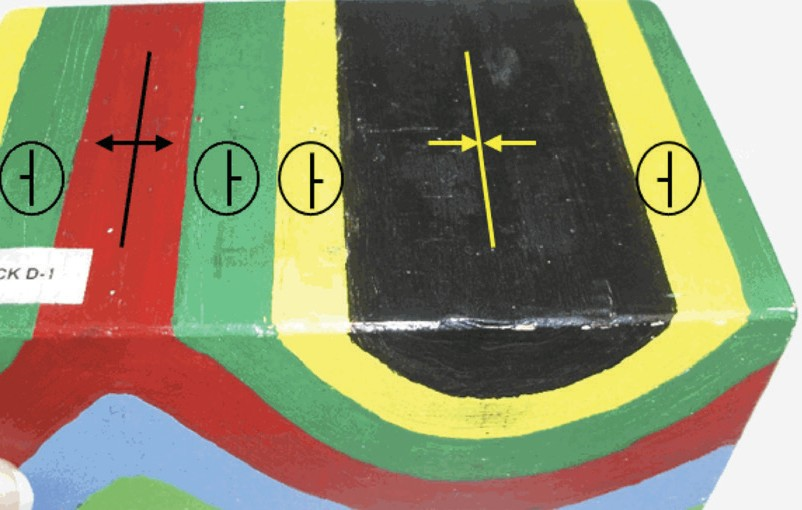
Once rocks are folded and exposed at Earth’s surface, they are subjected to erosion, creating certain patterns. The erosion exposes the interiors of the folds, and parallel bands of dipping strata can be observed along the fold axis. In an anticline, the oldest rocks are exposed along the fold axis, or core of the fold. In a syncline, the youngest rocks exposed at the fold axis, or core of the fold (Figure 8.22, Table 8.1).
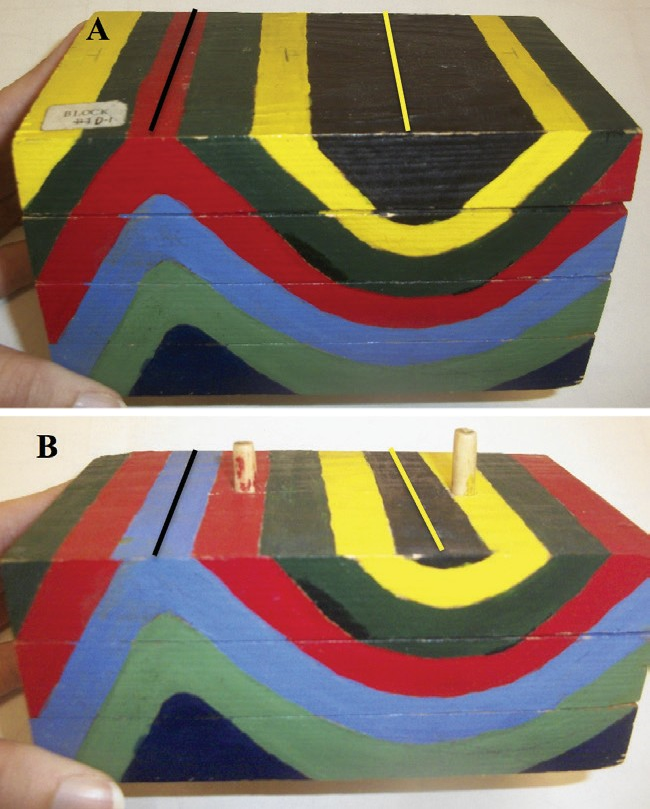
Table 8.1
| Fold Type | Direction of dip of beds | Age of beds in core |
| Anticline | Away from fold axis | Oldest |
| Syncline | Towards fold axis | Youngest |
So far, we’ve studied folds that contain a horizontal fold axis. These folds are shaped like ripples in water, with the axes of the folds lying in the tops and bottoms of the ripples. Some folds have a fold axis that plunges downwards, and these are called plunging folds. Let’s explore what beds might look like for a plunging fold. Take a piece of paper and create a fold by compressing the paper from either side. Tip the piece of paper along the fold axis so that the axis is no longer horizontal, and instead plunges in one direction. You have now created a plunging fold. Plunging folds create a V-shaped pattern when they intersect a horizontal surface (Figures 8.23, 8.24, and 8.25). In an anticline, the oldest strata can be found at the center of the V, and the V points in the direction of the plunge of the fold axis. In a syncline, the youngest strata are found at the center of the V, and the V points in the opposite direction of the plunge of the fold axis.
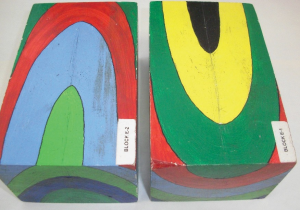

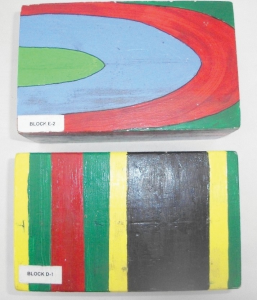
Source: Randa Harris (2015) CC BY-SA 3.0. view source.
Domes and basins are somewhat similar to anticlines and synclines; they are basically the circular (or elliptical) equivalent of these folds. A dome is an upwarping of Earth’s crust, which is similar to an anticline in terms of the age relationships of the rocks, and a basin is an area where the rocks have been warped downwards towards the center, with age relationships being similar to a syncline (Figure 8.26). The key to identifying these structures is similar to identifying folds. In a dome, the oldest rocks are exposed at the center, and rocks dip away from this central point. In a basin, the youngest rocks are in the center, and the rocks dip inward towards the center.
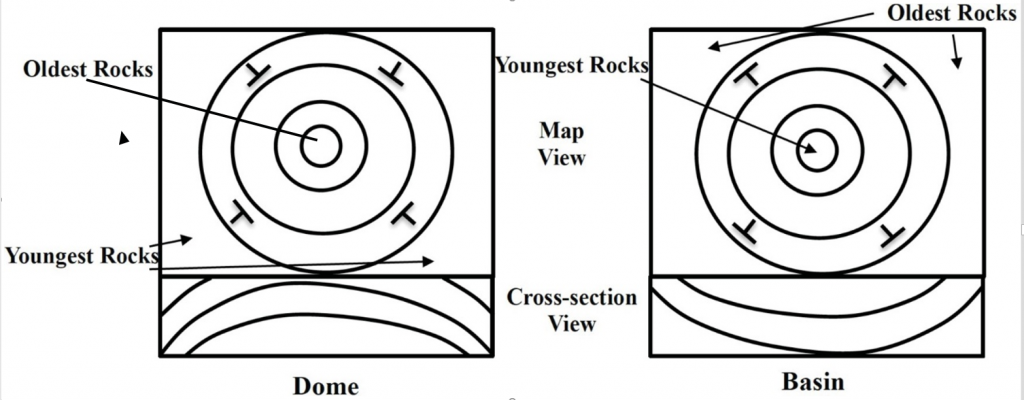
Here are some helpful hints to remember when constructing a cross-section for an area that includes folded strata:
- Anticlines – these folds have the oldest beds in the middle, with beds dipping away from the fold axis. Plunging anticlines plunge towards the closed end of the V.
- Synclines – these folds have the youngest beds in the middle, with beds dipping towards the fold axis. Plunging synclines plunge towards the open end of the V.
8.6.2 Faults
As rocks undergo brittle deformation, they may fracture. If no appreciable lateral displacement has occurred along fractures, they are called joints. If lateral displacement occurs, these fractures are referred to as faults. In dip-slip faults, the movement along the fault is either up or down. The two masses of rock that are cut by a fault are termed the fault blocks (Figure 8.27). The type of fault is determined by the relative direction that the fault blocks have moved.
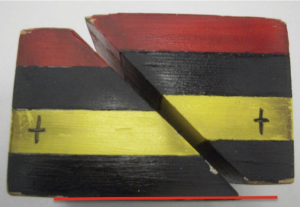
Fault block movement is described based on the relative movement of the hanging wall, the block located above the fault plane, and the foot wall, the block located beneath the fault plane. The term hanging wall comes from the idea that if a miner was climbing along the fault plane, they would be able to hang their lantern above their head from the hanging wall. For beginners, it is often useful to draw a stick figure straight up and down across a cross-section of the fault plane to help identify which wall is the hanging wall. The head of the stick figure will be on the hanging wall and the feet of the stick figure will be on the foot wall (Figure 8.28).

When extensional forces are applied to the fault blocks (e.g., in tectonic environments where tectonic plates are pulling apart, such as along the Mid-Atlantic Ridge), the hanging wall block will move down with respect to the foot wall block. This creates a normal fault. An easy way to remember that the hanging wall drops in a normal fault is to use the mnemonic “It’s normal to fall down”. As this happens, the crust is lengthened (stretched apart) and thinned (Figure 8.29).
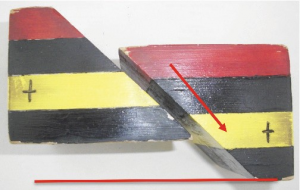
When compressional forces are applied to the fault blocks (such as in a convergent plate boundary tectonic setting), the hanging wall block will move up relative to the foot wall block, creating a reverse fault. This causes the crust to shorten laterally but thicken vertically (e.g., Figure 8.30). A special type of reverse fault is a thrust fault. A thrust fault is a low angle reverse fault (the dip angle is less than 30o). Table 8.2 summarizes the characteristics of normal and reverse faults.
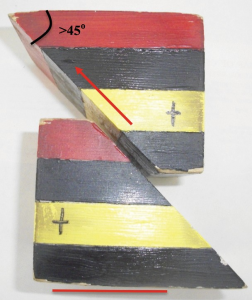
Table 8.2
| Fault type | Type of force | Direction* | Length of block | Crustal thickening or thinning |
| Normal | Extensional | Down | Lengthened | thinning |
| Reverse | Compressional | Up | Shortened | thickening |
* hanging wall block movement relative to foot wall block
Tensional forces acting over a region can produce normal faults that result in landforms known as horst and graben structures. In horst and graben topography, the graben is the crustal block that drops down relative to the crust around it. The graben is surrounded by two horsts; these are relatively uplifted crustal blocks (Figure 8.31). This terrain is typical of the Basin and Range province in the western United States.
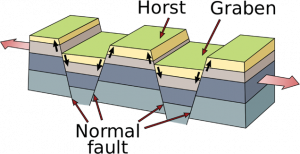
In dip-slip faults (normal and reverse faults), the fault movement has occurred parallel to the fault’s dip, and the movement is characterized by both a vertical and horizontal change in position of the hanging wall relative to the foot wall. In a strike-slip fault, the movement is only horizontal along the fault plane in the direction of strike (hence the name), the fault blocks do not move vertically relative to one another. Also, faults that behave as purely strike-slip faults are usually vertical in their orientation. The blocks on opposite sides of a strike-slip fault slide past each other, and the movement is driven by shear forces acting on the fault blocks on either side of the fault. The classic example of a strike-slip fault is the San Andreas Fault in California, USA (Figure 8.32). Strike-slip faults can be furthered classified as right-lateral or left-lateral strike-slip faults. To determine whether a fault is left- or right-lateral, use the following test. Imagine an observer standing on one side of the fault looking across at the opposite fault block. If the fault block on the opposite side of the fault appears to have moved right relative to the observer, it is right-lateral; if it appears to have moved left, it is left-lateral.
Figure 8.33 provides examples of all three fault types for your review.
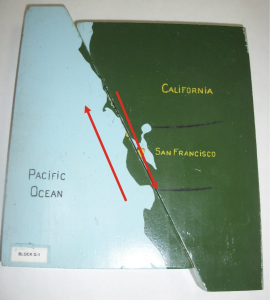
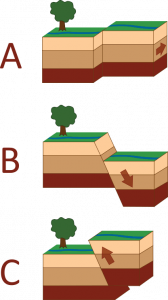
8.7 Unconformities on Geological Maps
Unconformities have been discussed in a previous section of this lab manual. Recall the definition of an unconformity: a gap in the geological record where a rock unit is overlain by another rock unit which was deposited substantially later in time. The unconformity is the gap in time between the rocks above and below. Also recall the different types of unconformities: (1) disconformity: a gap in time between parallel sedimentary rocks caused by either erosion or nondeposition during the time period; (2) nonconformity: a gap in time between crystalline (i.e. igneous and metamorphic) basement rock and the sedimentary rocks located immediately upon the basement rock. Nonconformities commonly span vast amounts of time, up to billions of years; and (3) angular unconformity: a gap in time in which a sequence of sedimentary rocks lies upon an older sequence of sedimentary rocks, but these older rocks were tilted so lie in a different orientation than the rocks above.
Identifying unconformities on geological maps can be difficult. Disconformities are almost impossible to locate, unless you are told the ages of the different layers of rocks. In that case, look for the gaps in time and you will locate any disconformities.
Nonconformities can also be tricky, as intrusive contacts can be mistaken for them. But if you locate sedimentary rocks that are located next to large swaths of igneous and metamorphic rocks, you have likely located a nonconformity. Figure 8.34 show examples of nonconformities: the sedimentary rocks of the Athabasca Basin, and the sedimentary rocks of the western Canadian Sedimentary Basin and Williston Basin all rest nonconformably on the metamorphic basement rocks of the Canadian Shield, with gaps in the rock record ranging from 1 – 2.7 Ga.
Angular unconformities can be very simple to locate on geological maps. Since overlying sedimentary rocks were deposited upon lower tilted units, these overlying rocks will drape on top of the lower units. If you follow along the contacts of the lower units, you will find that they all truncate against the angular unconformity. The boundary between the sedimentary rocks of the Western Canadian Sedimentary Basin and the Williston Basin are an example of an angular unconformity (Figure 8.34) that represents a gap in the rock record of 300 Ma.
